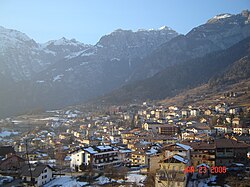San Lorenzo in Banale
| San Lorenzo in Banale | |
|---|---|
| Comune | |
| Comune di San Lorenzo in Banale | |

View of San Lorenzo in Banale
|
|
| Location of San Lorenzo in Banale in Italy | |
| Coordinates: 46°5′N 10°55′E / 46.083°N 10.917°E | |
| Country | Italy |
| Region | Trentino-Alto Adige/Südtirol |
| Province / Metropolitan city | Trentino (TN) |
| Frazioni |
Berghi, Dolaso, Glolo, Senaso, Prato, Prusa, and Pergnano. telephone = 0465 |
| Government | |
| • Mayor | Gianfranco Rigotti |
| Area | |
| • Total | 62.1 km2 (24.0 sq mi) |
| Elevation | 758 m (2,487 ft) |
| Population (31 December 2014) | |
| • Total | 1,157 |
| • Density | 19/km2 (48/sq mi) |
| Demonym(s) | Sanlorenziani |
| Time zone | CET (UTC+1) |
| • Summer (DST) | CEST (UTC+2) |
| Postal code | 38078 |
| Website | Official website |
Berghi, Dolaso, Glolo, Senaso, Prato, Prusa, and Pergnano.
San Lorenzo in Banale (German: Sankt Lorenz) is a comune (municipality) in Trentino in the northern Italian region Trentino-Alto Adige/Südtirol, located about 15 kilometres (9 mi) west of Trento. The comune is made up of seven merged hamlets or villages. They are Berghi, Dolaso, Glolo, Senaso, Prato, Prusa and Pergnano. Moline, Deggia, and Nembia are three other nearby hamlets that are also a part of San Lorenzo in Banale.
San Lorenzo in Banale borders the following municipalities: Ragoli, Molveno, Andalo, Vezzano, Stenico, Dorsino, Calavino and Comano Terme.
Ciuìga is a locally produced sausage made with pork, turnips, and pepper. It is then smoked using juniper branches and served during the winter months accompanied with polenta, sauerkraut, or potatoes. The name originates from the local dialect word for pine cone, because of its shape and size. It is also a Slow Food presidium.
...
Wikipedia

